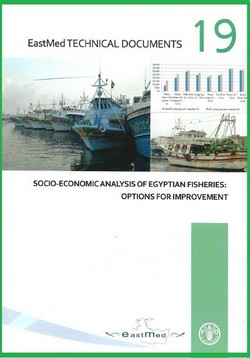
Eastmed Technical Documents 19
Socio-Economic Analysis of Egyptian Fisheries:
Options for Improvement
Preface
The Project “Scientific and Institutional Cooperation to Support Responsible Fisheries in the Eastern Mediterranean - EastMed is executed by the Food and Agriculture Organization of the United Nations (FAO) and funded by Greece, Italy and EC.
The Eastern Mediterranean countries have for long lacked a cooperation framework as created for other areas of the Mediterranean namely the FAO sub-regional projects AdriaMed, MedSudMed, CopeMed II and ArtFiMed. This made it more difficult for some countries in the region to participate fully in international and regional initiatives for cooperation on fishery research and management following the very encouraging experience of technical and institutional assistance provided to countries by the other FAO sub-regional Projects.
EastMed
Was born to support the development of regional cooperation and the further development of multidisciplinary expertise necessary to formulate appropriate management measures under the FAO Code of Conduct for Responsible Fisheries and the principles of the Ecosystem Approach to Fisheries (EAF) to ensure rational, responsible and participative fisheries management.
The project’s longer-term objective is to contribute to the sustainable management of marine fisheries in the Eastern Mediterranean, and thereby to contribute to supporting national economies and protecting the livelihoods of those involved in the fisheries sector.
The project’s immediate objective is to support and improve the capacity of national fishery departments in the sub-region to increase their scientific and technical information base for fisheries management and to develop coordinated and participative fisheries management plans in the Eastern Mediterranean sub-region.
Abstract
This study was implemented after the Eastmed 2ⁿᵈ co-ordination meeting on the 5-6th April, Antalya, Turkey (Eastmed 2012), where the participants agreed to have a preliminary assessment of the socio-economic situation of the Egyptian fisheries sector. In order to undertake such an assessment several information was gathered, from literature, from several fishers and other stakeholders, and a sampling survey in order to investigate the main socio-economic characteristics of the motorized fishing vessels by type of fishery. n general the study found that the value of capture fisheries produced by the motorized fleet in the Mediterranean was $182 million generating a net profit of $42.5 million. The ex-vessels prices ranged between $2.4/Kg and $4.3/Kg, and the first sale of seafood products occurred mostly through the auction markets (56%) and through the wholesalers (40%). he revenue of the fleet provided an annual salary of about $2,662 per fisher to about 22,173 fishers, which is much higher than the official minimum wage of the country ($1,416). This relatively higher salary comes from the fact that the industry is heavily subsidized by the very low cost of fuel. The main problem in Egyptian motorized fisheries seems to be the overcapacity of the trawl fleet, which has led to an overexploitation of resources. The overcapacity of trawlers is most likely driven by the highly subsidised fuel, which led to substantial profits, but however making the sector extremely vulnerable to any minimum change in the subsides and/or average price of fuel. The employment and salaries are the factors with a higher risk. Management measures should be taken to reduce the capacity of the trawl fleet such as improved enforcement on the use of trawl gears and a diversification of the fleet into other fishing activities such as vessels using passive gears. However such management measures should be developed within the context and methodology of the Ecosystem Approach to Fisheries (EAF), in which together with the various stakeholders management plans could be drawn up.
Table of Contents
<!--Introduction
<!--National macro-economic context
<!--The fishing fleet
<!--[if !supportLists]-->· The fishing gears and equipment
<!--The production
<!--Status of the stocks
<!--Trade import, export, per capita consumption and marketing
<!--Employment, Fisher’s Organizations and Inflation
<!--Fisheries Legislation in Egypt
<!--[if !supportLists]-->2. Materials and Methods
<!--Population and stratification of the fishing fleet.
<!--The non-motorized fleet
<!--Sample survey
<!--Data analysis
<!--Results
<!--Fishing Fleet data for 2011
<!--Questionnaire Survey
<!--Benchmarking - ex-vessel prices
<!--Input factors (harvesting costs)
<!--First sale (ex-vessel) market dynamics
<!--Social characteristics of the fishers
<!--Quality indicators Coefficient of Variation
<!--Discussion
<!--[if !supportLists]-->· The Egyptian Fishing Fleets, their Activity and Management.
<!--Economic performance of the fleet
<!--Ex-vessel market dynamics
<!--Socio-economic characteristics of the fishers
<!--[if !supportLists]-->5. Conclusions and Recommendations
6. References



ساحة النقاش